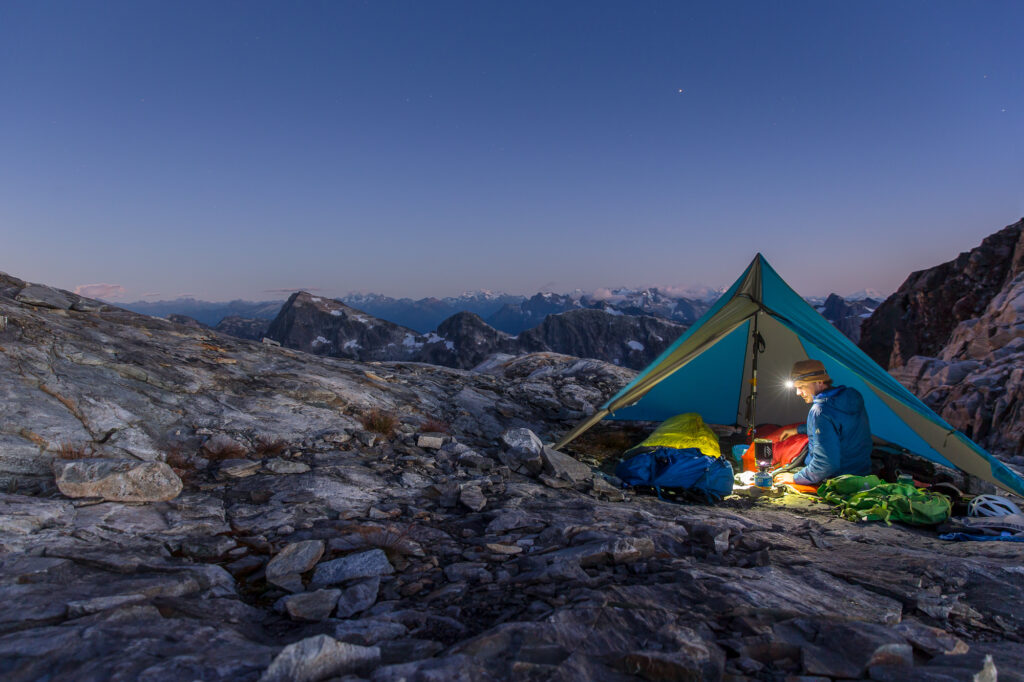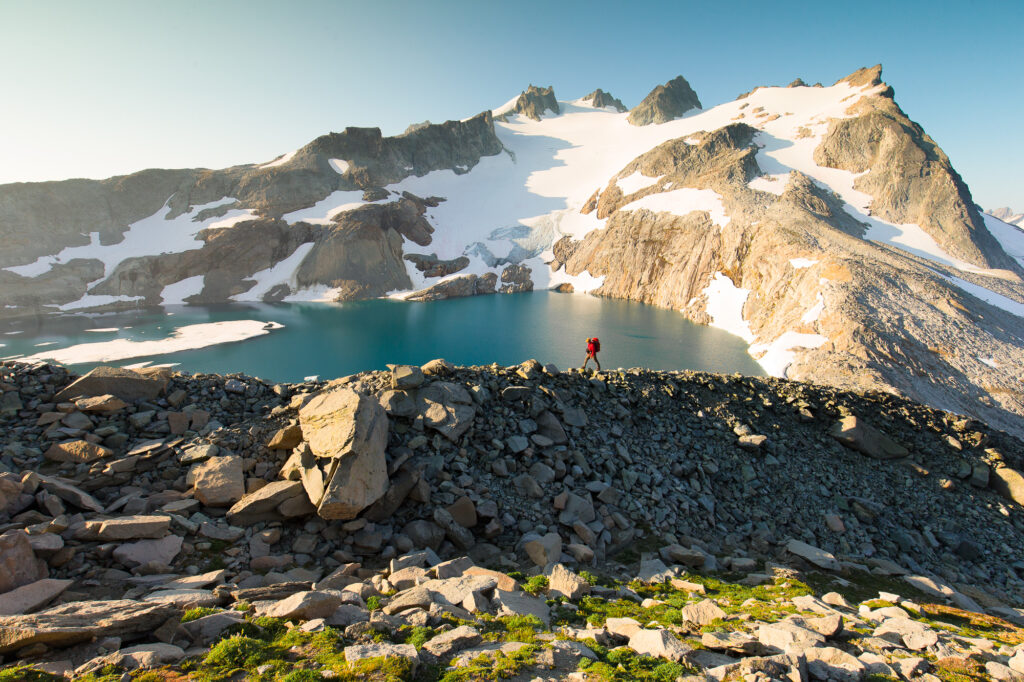
Camping In The Alpine – Stuff You Should Know

For those who are willing to seek it out, the alpine can be a backpackers sanctuary offering panoramic views, other worldly terrain and remote destination activities. John Muir, when writing about the alpine meadows of the Sierra Nevada, felt his words were inadequate to describe “the exquisite beauty of these mountain carpets as they lie smoothly outspread in the savage wilderness” (Muir 1894).

Environments
Alpine ecosystems are typically defined as those areas occurring above treeline. They extend beyond the typically envisioned high-elevation open slopes and summits of cold-adapted shrubs to also include rocky environments such as cliffs, talus fields, boulder fields, permanent icefields. They can include glaciers, and various water bodies such as streams, tarns, and large lakes. Alpine ecosystems provide severe natural stresses for both the animal and plants who call it home. These environmental stresses include low winter temperatures, short growing season, low nutrient availability, high winds, and summer water droughts. Due to these factors there are often specific regulations to protect the well being of the delicate flora. While most of us don’t intend to harm these places that we love, we may lack the knowledge to preserve it, or perhaps overlook a few important behaviors. Before your next trip, if you haven’t done so already, familiarize yourself with the seven “Leave No Trace” principles so that we don’t love these places to death.
- Plan ahead and prepare.
- Travel and camp on durable surfaces.
- Dispose of waste properly.
- Leave what you find.
- Minimize campfire impacts (be careful with fire).
- Respect wildlife.
- Be considerate of other visitors.

Weather
There will always be inherent danger in visiting the mountains, especially their rugged, upper elevation, alpine environments. An important thing to know ahead of any backpacking trip in these places is what the weather is going to do; this will likely affect what’s in your pack and list of objectives. If you’re strong willed and determined to reach your destination, bulking up your gear may be necessary. In the winter months temperatures can plummet well below freezing making travel and extended stay difficult without proper preparation. Having a GPS device that can provide weather updates is ideal however, packing some form of printed forecast that covers the duration of your stay works as well.
Weather can quickly change in the mountains, particularly if there is a cold front. There are often no warning signs and it can happen very abruptly, always take this into account both while planning and during the trek. Check the sky often and try to get to a safe location before a storm front arrives.
We differentiate between two different summer storms, “frontal storms” and “heat storms.” A heat storm is a localized weather occurrence and can be recognized by the cumulus clouds that form and take on a tower shape. Heat storms usually occur from midday to the afternoon, they are localized and can be very dangerous to be caught in. If you find yourself climbing or trekking in an exposed position and begin to recognize the initial signs-there is only one option- execute an immediate retreat.
Frontal storms often show themselves at the end of a period of fine weather in the form of a sudden drop in temperature and menacing dark clouds.
When spending time in the alpine, it is important to be able to recognize the signs of storms and their alarm signals. Fast cumulus clouds, anvil-shaped clouds, gusts of wind, showers and electrical charge (which you’ll recognize from metal objects buzzing or your hair standing on end) are all alarm signals for impending storms. If caught in a storm you should retreat to a shelter as fast as possible, ideally in a valley away from flowing water or at least away from ridges or summits where lightning is most likely to strike. It’s also important to get away from metal items such as ice axes and carabiners because they conduct and attract lightning.
Gear
As unique and variable are the different climates, so is the list of gear you may find yourself needing. Much of your normal backpacking arsenal will stay the same but depending on the season and region you may need to switch some things around.
Tent – Generally speaking a three season tent is always necessary for the alpine. Windy weather and storms can roll in unexpectedly and you’ll need to be able to fend off these conditions. When camping in the snow, consider switching to a tarp-like shelter and/or digging into the snowpack to form a makeshift bunker sleeping area. This technique will protect you from elements while also saving you weight since you won’t be needing tent poles. Trekking poles are useful to prop the center of the shelter and it is often handy to have extra rope or twine to secure the corners of the tarp.
Stove/Fire/Heat – Specifically for winter camping, water is not usually easy to find and melting snow can consume a lot of fuel so we suggest planning accordingly. If you plan on spending a significant amount of time in the alpine, a large pot and the UCO Gear Flat Pack Mini Grill works great as a source of heat and a great means to boil large amounts of water. Remember to pack your lighter in a plastic baggie and/or bring waterproof matches. Another great emergency tool is the UCO Gear Stormproof Torch with utility tape, both waterproof and much more efficient than your typical lighter.
Navigation – While the ability to use a traditional map and compass is a great skill to have, these days it’s not the only reliable way to navigate off trail or in the alpine. Today’s GPS (Global Positioning System) units such as the Garmin InReach Mini are incredibly useful, albeit pricey. Out of all the apps on the market, the GAIA GPS app is the best. It allows you to download maps and terrain specific to where you’ll be traveling and use them when you’re offline or on airplane mode conserving battery life. Just remember to download the maps before you lose service and that your phone is your source of direction, packing a small backup power bank is recommended.
Food Storage – Many national parks and wilderness areas recommend (if not require) food containers or odor proof bags to protect from unwanted interactions with bears and varmints. While the idea of a bear coming into camp and stealing food is troublesome, the more likely scenario is waking up to a gang of alpine Pika ravaging your food bag or one large marmot enjoying your bag of M&M’s. Consider the 4pc Mess Kit by UCO Gear as a great option for keeping food safe from rodents.
Bring a book – When storms hit or long winter nights start to bring you down, pack a good book to pass the time.
Trim your toenails – Sounds weird but trust us, the last thing you want is to lose a nail or have to try and trim that gnarly claw with a knife on the side of the trail.
Newspaper – When things get wet and cold and if you’re unable to start a fire to dry your gear out, particularly your boot liners, pack some newspaper to stuff into your boots to absorb the moisture.

